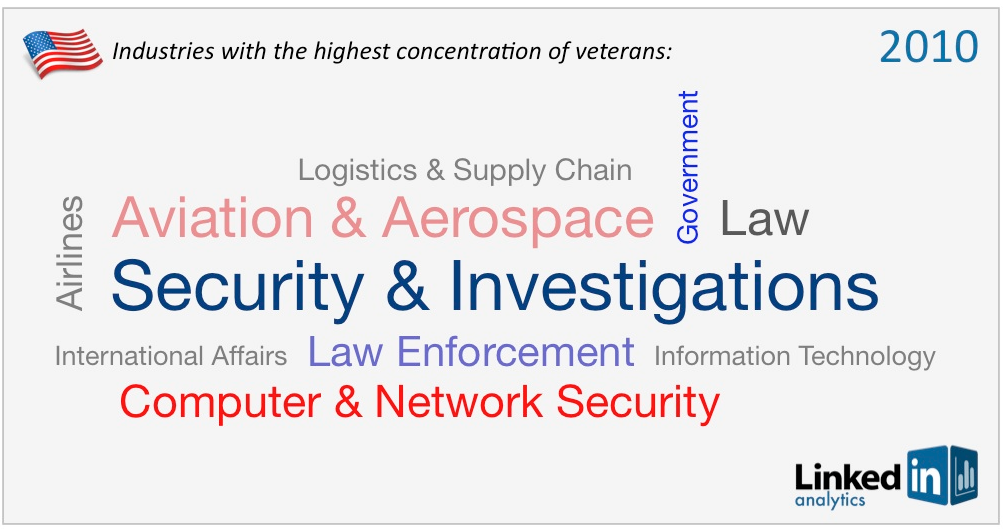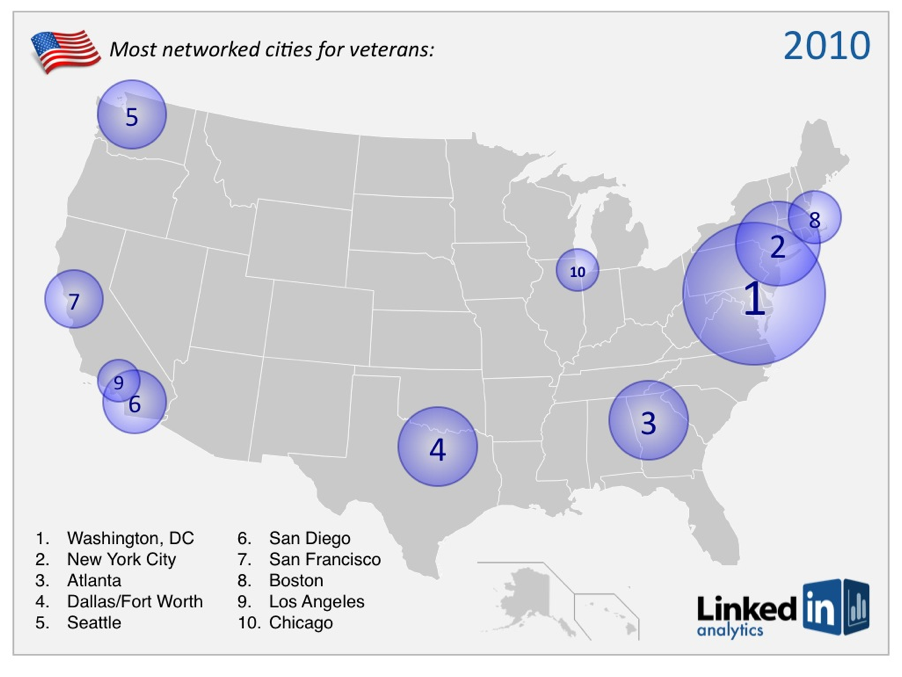Veterans – where are they now?
Today is Veterans Day here in the US where we honor those that have served in the military. The most recent statistics from the US Bureau of Labor Statistics show a worsening employment situation among veterans. In these challenging economic times we dug into our data to see if we could identify useful insights relevant for veterans. We also put together a list of LinkedIn tips for veterans, from veterans who work at LinkedIn.
There are nearly half a million LinkedIn members with U.S. military service listed on their profile. For these veterans, here are the top 10 industries in terms of the total number of LinkedIn members currently working in that industry:
What’s interesting about the above list is that most veterans are taking their specialized skill sets and applying them to a wide range of industries (most of which are not immediately associated with the military). It’s a good reminder that a veteran’s skills are broadly applicable.
As an example of the diverse skill sets we know our veterans can apply, here are a few members of our own team at LinkedIn who have served.
- Wil Bolivar, engineering manager at LinkedIn
- Chris Brown, enterprise relationship manager at LinkedIn
- Hans Brough, senior web developer at LinkedIn
- Paul Erickson, risk lead at LinkedIn
- Terry LaRock, corporate purchasing management at LinkedIn
- Amber Mercado, enterprise services representative at LinkedIn
- Tim Stanton, senior account executive for LinkedIn Hiring Solutions
- Ted Treiber, engineering infrastructure manager at LinkedIn
- Sam Mandolfo, enterprise account executive at LinkedIn
When we dug deeper into the data we wondered why we didn’t see some of the traditional industries that might have been expected. Once we normalized the data for the top 10 non-military and non-defense industries in terms of the concentration of veterans, the more traditional industries pop up:
What does the above chart say when taken together with the first one? It paints a picture of another great networking opportunity for veterans. The disproportionately high share of veterans in each of these industries suggests that veterans also look into directly transferring their military skill set into one of the above-related professions.
Along that direction we also identified the top locations for networking with other veterans. The graphic below shows the top 10 metropolitan areas in terms of the number of people on LinkedIn who have served in the military. Even though the concentration of veterans may be higher in certain areas (for example, close to a military base), the highest volume of networking opportunities is in the major metropolitan areas.
Finally, on a day honoring our veterans, here are our tips for veterans that are looking to get the most out of LinkedIn:
1. Build Your Network - Make sure your LinkedIn network is made up of at least 35 connections. Connect with current and former soldiers, sailors and Marines, college classmates, former co-workers and even friends and family since they know professionals in other industries.
2. Find Like-Minded Professionals - Join military related groups on LinkedIn so you can network and share best practices with one another. The five largest military related groups on LinkedIn are: U.S. Veteran, US Military Veterans Network, US Army, US Navy Veterans and Semper Fi Network - United States Marine Veterans – USMC. Also find and join groups that are focused on industry topics you’re interested in like “telecom” or “advertising”. Get creative and join groups about topics you are passionate about.
3. Open the Door to Opportunities - Make sure your LinkedIn Profile is 100 percent complete and include descriptive phrases your work experience like the kinds of teams you were responsible for, programs you enacted that helped increase effectiveness, what countries you worked in, etc. Professionals use LinkedIn Advanced Search to search for keywords like “engineering,” or “government consulting." Highlight your abilities in developing leaders, building strong teams, and overcoming difficult challenges. Include the units you served with and the ships you were aboard to help other veterans find you. If this info isn’t in your profile then clients, peers and potential employers won’t find you and you may be missing out on opportunities.
4. Uncover Great Contacts in Your Backyard - Use LinkedIn Advanced Search to find mentors if you’re looking to do a complete career switch. If you’re want to become a photographer, lawyer or sales executive do a search by title for people that currently hold those positions and are based near your zip code. Reach out to them to see if they’d be willing to give you tips and advice on getting into that profession. You can also use this technique to search for recruiters and hiring managers that live in your city or a city you’d be interested in moving to. Click on the person’s profile and you’ll see if anyone in your network knows them and can introduce you.
5. Find Your Dream Job - LinkedIn makes it easy for professionals to follow LinkedIn Company Pages and stay updated on senior level changes and new hires at companies you care about. Search for your dream employers’ company page and click "Follow Company" to get regular updates on hiring, promotions, departures and job listings as soon as they happen.
Most of all, to all the veterans out there, thank you for your service!





